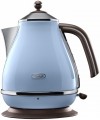Design
The design in which the electric kettle is decorated. In addition to
the classic design, nowadays there are more original styles, namely:
—
Retro. Devices stylized antique — mainly for kitchen utensils of the 30s — 50s of the XX century. The degree of stylization in this case can be different: for example, some appliances are not different from ordinary kitchen kettles that are placed on the stove. Also note that almost all samovars are performed in retro style (see "Type"). But thermopots and teapots in this design are almost never produced. Anyway, a retro kettle will be indispensable for a kitchen in the same style, but it can also fit into a modern interior.
—
Hi-tech. The devices that have a technological, sometimes even futuristic design — using unpainted metal, transparent glass, as well as a minimal amount (or even complete absence) of decorative details. At the same time, the design can be quite unusual: for example, there are models that taper upward and vaguely resemble laboratory flasks. Like the retro style, almost no other devices are produced in this style other than classic kettles.
When choosing a device in a specific design, note that the design inevitably affects the cost — sometimes quite noticeably, despite the fact that it usually does not provide functional advantages.
Power consumption
The power consumed by the kettle during operation is actually the power of the heating element installed in the device.
Two working moments depend on this parameter: heating intensity and electricity consumption. On the one hand, the
high power of the heater allows you to quickly heat up a certain volume of water and saves time. On the other hand, the power consumption of such a device will also be appropriate. The wattage of a kettle's heater typically does not have a significant impact on electricity bills since the energy consumption required to heat a given volume of water remains the same regardless of the heater's power rating. However, there may be certain issues related to electrical connectivity. For example, if the wiring is weak or the fuses are improperly sized, the operation of a high-power heater may cause power outages. Additionally, devices with a power rating greater than 3500 W cannot be connected to a regular electrical outlet and require a specific power format. Consequently, even the largest thermal pots, which typically have a capacity of 10 L or more, are rarely equipped with heaters more powerful than 3000 W, since this power rating is sufficient for their intended use and can be connected to a standard electrical outlet.
Water level indicator
A device that allows you to estimate the amount of water in the kettle without opening its lid. Most often
the water level indicator has the form of a scale applied either to the transparent wall of the container, or to a transparent insert in an opaque wall. In any case, this function allows you to measure the volume of filled water quite accurately, and not just determine it “by eye”. This possibility is especially important for models with open coils (see "Heating element"), in such devices, a mark on the indicator is usually applied to the minimum allowable water level.
Removable lid
The ability to completely remove the lid of the kettle. Such a possibility is not of particular importance during regular use, however, it provides additional convenience if the kettle needs to be washed from the inside — a
removable lid, unlike a traditional non-removable one, will not hang on the fixture, hit your hands and create other discomforts. On the other hand, there is a certain risk of losing this lid, so this feature is not common.
Opening the lid with a button
Kettles (see "Type") in which the lid opens at the touch of a button. This opening is faster and more convenient, and often safer than the traditional way (grab the lid and pull it up): the lid can get quite hot when the kettle is in operation, and long contact with it is fraught with burns. And although the button can also be placed on the lid, a short press is enough to activate it, and even in such cases the risk of getting burned is minimal. On the other hand,
opening the lid with a button complicates the design of the kettle and reduces its reliability.
Body shape
The general shape of the body of the electric kettle.
—
Conical. The most popular option: a body is wide at the base and tapering upwards. This form contributes to stability: the centre of gravity is maximally displaced downwards. However washing such a kettle from the inside may not be very convenient due to the relatively small size of the opening in the upper part.
—
Cylindrical. The cylindrical shape provides more or less the same width of the body at the base and at the top. With the same height and base diameter, such kettles hold slightly more water than conical ones; in addition, such a device is easier to clean due to the wide opening for the lid.
—
Inclined. The body which is inclined forward; the width of such a body is usually more or less the same over the entire height. Such kettles have an unusual, eye-catching appearance; in addition, it is easier to pour water from them — the device must be inclined at a smaller angle than with a cylindrical and even with a conical body. However, this option does not provide fundamental advantages over the same cylindrical shape, but it is more expensive, and therefore is not common.
Backlight
Decorative lighting of the body or capacity of the kettle. It has mainly aesthetic value — it improves the appearance of the device. Sometimes it can serve as a kind of indicator, for example, change the colour when water is boiling.

